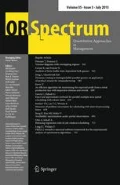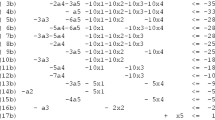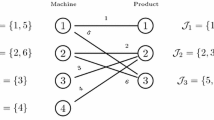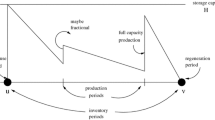Abstract
In this paper we consider a single-stage system where a number of different items have to be manufactured on one machine. Expenditures for the setups depend on the sequence in which items are scheduled on the machine. Holding costs are incurred for holding items in inventory. The demand of the items has to be satisfied without delay, i.e. shortages are not allowed. The objective is to compute a schedule such that the sum of holding and setup costs is minimized with respect to capacity constraints. For this problem which we call capacitated lot-sizing problem with sequence dependent setup costs (CLSD) we formulate a new model. The main differences between the new model and the discrete lot-sizing problem with sequence dependent setup costs (DLSDSD), introduced by Fleischmann, is that continuous lot-sizes are allowed and the setup state can be preserved over idle time. For the solution of the new model we present a heuristic which applies a priority rule. Since the priority values are affected by two significant parameters, we perform a local search in the parameter space to obtain low cost solutions. The solution quality is analyzed by a computational study. The comparison with optimal solutions of small instances shows that the solution quality of our heuristic is acceptable. The Fleischmann approach for the DLSPSD computes upper bounds for our new problem. On the basis of larger instances we show that our heuristic is more efficient to solve the CLSD.
Zusammenfassung
Dieser Beitrag beschäftigt sich mit der Ablaufplanung für eine Engpaßmaschine unter besonderer Berücksichtigung reihenfolgeabhängiger Rüstkosten. Neben Rüstkosten sind von Losgrößen abhängige Lagerkosten entscheidungsrelevant. Die Losgrößen sind dabei unter Berücksichtigung der Maschinenkapazität in einem vorgegebenen Planungszeitraum so zu bestimmen, daß alle Teilebedarfe termingerecht in ausreichender Menge befriedigt werden. Zur Lösung des Planungsproblems entwickeln wir zunächst ein neues Modell. Es unterscheidet sich von dem von Fleischmann eingeführten Modell (the discrete lot-sizing problem with sequence dependent setup costs, DLSPSD) dadurch, daß es statt diskrete kontinuierliche Losgrößen zuläßt und daß der Rüstzustand bei Stillstand der Maschine erhalten bleibt. Zur Lösung des Problems wird eine prioritätsregelbasierte Heuristik vorgeschlagen. Die Prioritätswerte und dadurch auch die Lösungsgüte des Verfahrens hängen von zwei Parametern ab. Ein Suchverfahren zur Bestimmung geeigneter Parameterwerte wird vorgestellt. Anhand kleinerer optimal gelöster Datensätze wird gezeigt, daß die Lösungsgüte der Heuristik akzeptabel ist. Für größere Datensätze wird ein Vergleich mit dem von Fleischmann für das DLSPSD vorgeschlagenen Verfahren durchgeführt. Das Verfahren von Fleischmann liefert, bedingt durch die diskrete Losgrößenbildung, nur eine obere Schranke für die hier betrachtete Problemstellung. Der Vergleich zeigt, daß die prioritätsregelbasierte Heuristik dem Verfahren von Fleischmann hinsichtlich der betrachteten Problemstellung überlegen ist.
Similar content being viewed by others
References
Dilts DM, Ramsing KD (1989) Joint lot-sizing and scheduling of multiple items with sequence dependent setup costs. Dec Sci 20:120–133
Dobson G (1992) The cyclic lot scheduling problem with sequence-dependent setups. Oper Res 40:736–749
Drexl A, Haase K (1993) Sequential-analysis-based randomized-regret-methods for lot-sizing and scheduling. Discussion Paper, University of Kiel. J Oper Res Soc (to appear)
Fleischmann B (1990) The discrete lot-sizing and scheduling problem. Eur J Oper Res 44:337–348
Fleischmann B (1994) The discrete lot-sizing and scheduling problem with sequence-dependent setup costs. Eur J Oper Res 75:395–404
Fleischmann B, Popp Th (1989) Das dynamische Losgrößenproblem mit reihenfolgeabhängigen Rüstkosten. In: Pressmar D et al. (eds) Operations Reserach Proceedings 1988 Springer, Berlin, pp 510–515
Haase K (1994) Lot-sizing and scheduling for production planning. Springer, Berlin
Kimms A, Multi-level, single-machine lot-sizing and scheduling (with initial inventory). Working Paper University of Kiel 1993. Eur J Oper Res (to appear)
Schrage L (1982) The multiproduct lot scheduling problem. In: Dempster MAH et al. (eds) Deterministic and stochastic scheduling. Dordrecht, Holland, pp 233–244
Schrage L (1986) Linear, integer and quadratic programming with LINDO. 3rd edn. The Scientific Press, Redwood City
Thizy JM, Van Wassenhove LN (1985) Lagrangean relaxation for the multi-item capacitated lot-sizing problem: A heuristic implementation. IIE Transact 17:308–313
Author information
Authors and Affiliations
Rights and permissions
About this article
Cite this article
Haase, K. Capacitated lot-sizing with sequence dependent setup costs. OR Spektrum 18, 51–59 (1996). https://doi.org/10.1007/BF01539882
Received:
Accepted:
Published:
Issue Date:
DOI: https://doi.org/10.1007/BF01539882
Key words
- Lot-sizing
- scheduling
- discrete lot-sizing and scheduling
- sequence dependent setup costs
- local search
- production planning and control




